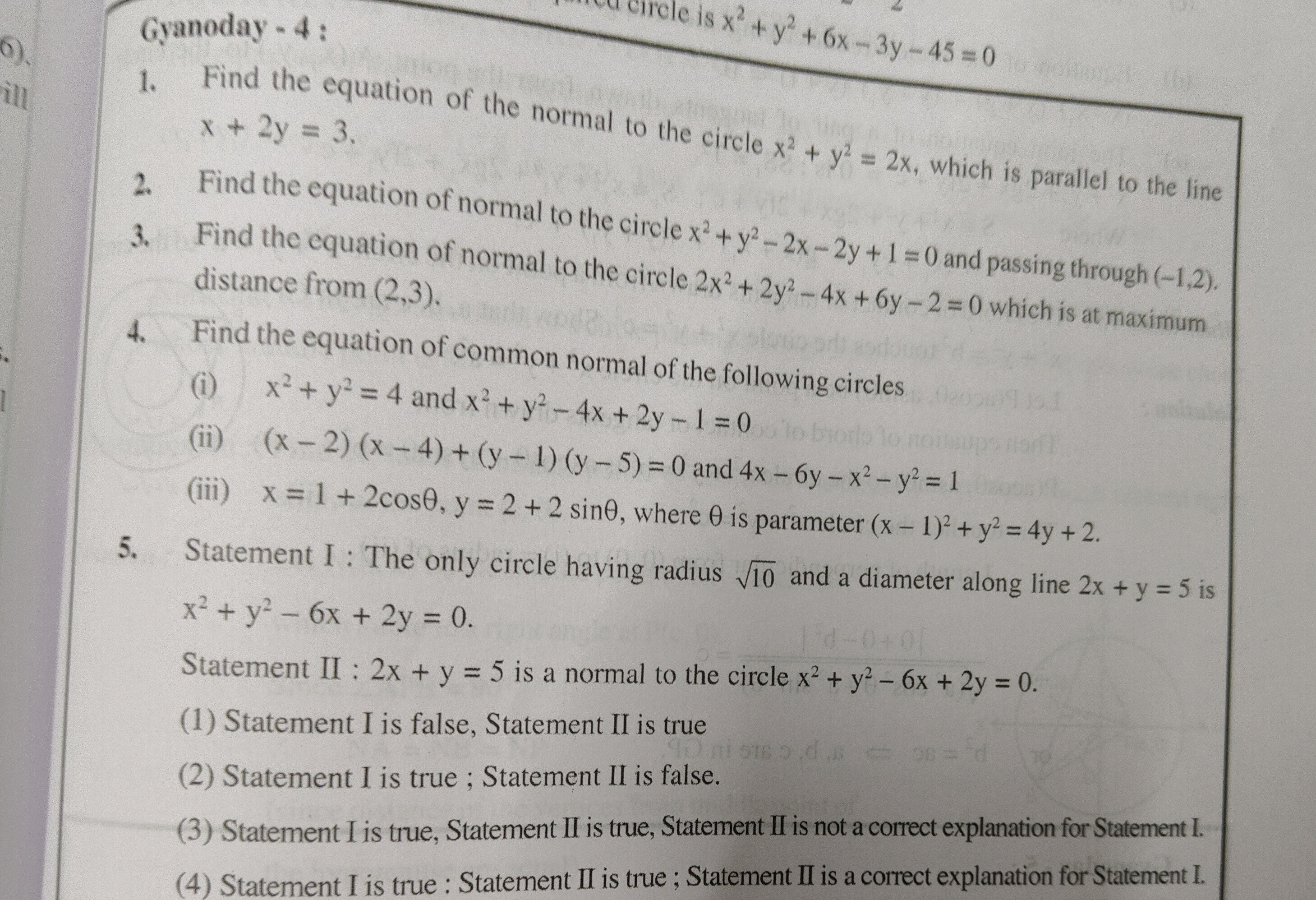Question
Question: 1. Find the equation of the normal to the circle $x^2 + y^2 = 2x$, which is parallel to the line $x ...
- Find the equation of the normal to the circle x2+y2=2x, which is parallel to the line x+2y=3.
- Find the equation of normal to the circle x2+y2−2x−2y+1=0 and passing through (-1,2).
- Find the equation of normal to the circle 2x2+2y2−4x+6y−2=0 which is at maximum distance from (2,3).
- Find the equation of common normal of the following circles (i) x2+y2=4 and x2+y2−4x+2y−1=0 (ii) (x−2)(x−4)+(y−1)(y−5)=0 and 4x−6y−x2−y2=1 (iii) x=1+2cosθ,y=2+2sinθ, where θ is parameter (x−1)2+y2=4y+2.
- Statement I : The only circle having radius 10 and a diameter along line 2x+y=5 is x2+y2−6x+2y=0. Statement II : 2x+y=5 is a normal to the circle x2+y2−6x+2y=0.

Statement I is false, Statement II is true
Statement I is true; Statement II is false.
Statement I is true, Statement II is true, Statement II is not a correct explanation for Statement I.
Statement I is true : Statement II is true; Statement II is a correct explanation for Statement I.
(1) Statement I is false, Statement II is true
Solution
Problem 1: The circle is x2+y2−2x=0, which is (x−1)2+y2=1. The center is (1,0). Normals to a circle pass through its center. The line x+2y=3 has a slope of −21. Since the normal is parallel to this line, its slope is also −21. The equation of the normal is y−0=−21(x−1), which simplifies to x+2y=1.
Problem 2: The circle is x2+y2−2x−2y+1=0, which is (x−1)2+(y−1)2=1. The center is (1,1). A normal passes through the center. The normal also passes through (−1,2). The slope of the line joining (1,1) and (−1,2) is −1−12−1=−21=−21. The equation of the normal is y−1=−21(x−1), which simplifies to x+2y=3.
Problem 3: The circle is 2x2+2y2−4x+6y−2=0, which simplifies to x2+y2−2x+3y−1=0. The center is (1,−23). Normals pass through the center. The distance from (2,3) to a normal is maximized when the normal is perpendicular to the line joining the center (1,−23) and the point (2,3). The slope of the line joining these points is 2−13−(−23)=19/2=29. The slope of the normal is the negative reciprocal, −92. The equation of the normal is y−(−23)=−92(x−1), which simplifies to 4x+18y+23=0.
Problem 4 (i): Circle 1: x2+y2=4, center (0,0). Circle 2: x2+y2−4x+2y−1=0, center (2,−1). A common normal must pass through both centers. Since the centers are distinct, there is no common normal.
Problem 4 (ii): Circle 1: (x−2)(x−4)+(y−1)(y−5)=0⟹x2+y2−6x−6y+13=0. Center (3,3). Circle 2: 4x−6y−x2−y2=1⟹x2+y2−4x+6y+1=0. Center (2,−3). The common normal is the line passing through both centers (3,3) and (2,−3). The slope is 2−3−3−3=6. The equation is y−3=6(x−3), which simplifies to 6x−y−15=0.
Problem 4 (iii): Circle 1: x=1+2cosθ,y=2+2sinθ⟹(x−1)2+(y−2)2=4. Center (1,2). Circle 2: (x−1)2+y2=4y+2⟹(x−1)2+(y−2)2=6. Center (1,2). Both circles are concentric with center (1,2). Any line passing through the common center is a common normal. The equation x=1 is a vertical line passing through (1,2).
Problem 5: Statement I: The circle x2+y2−6x+2y=0 has center (3,−1) and radius 10. The line 2x+y=5 passes through (3,−1), so it is a diameter. However, there are infinitely many circles with radius 10 and a diameter along 2x+y=5, as any point on 2x+y=5 can be the center. Thus, Statement I is false. Statement II: The line 2x+y=5 passes through the center (3,−1) of the circle x2+y2−6x+2y=0. Therefore, it is a normal to the circle. Statement II is true. Since Statement I is false and Statement II is true, option (1) is correct.
